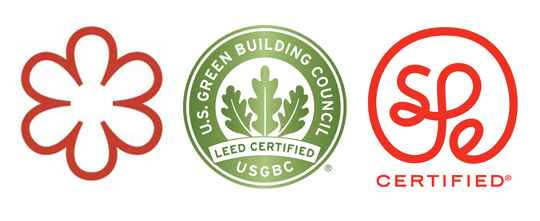
Reducing Food Waste in Foodservice
October 16, 2018 by Doreen Garelick, Dietetic Intern
Our intern Doreen attended a food waste summit for restaurants and compiled these tips to help food service operators redirect…
SPE Advisors
September 24, 2012

Arlin Wasserman, founder of Changing Tastes, discusses how certifications have a decades long record of helping restaurants and the hospitality industry.
We’re eating out more than ever these days. More than half the money we spend on food in the U.S. goes to buy food prepared in restaurants for us to eat there, at home, or in our cars. That trend started more than sixty years ago and has led to increasing success in the restaurant and hospitality industry, along with greater interest among diners in where to get good food, how it was prepared, and how good it will be for my health and the health of family.
One driver of success over these six decades has been a series of certification programs that have helped recognize businesses that provide better services and also have grown their market.
A few decades back, restaurants and hotels in America competed for certification from the American Automobile Association. AAA certification and its diamond quality ranking drove restaurants and hotels to make sure they had the right set of food and hospitality service to provide a safe, clean and friendly visit. Competing for four diamonds when the AAA inspector comes to visit remains a goal for some businesses while the basic certification is now used by almost everyone restaurant and hotel.
And the AAA certification also let families know it was safe to take a very long drive across America and dine along the way. AAA’s certification helped make the family road trip a part of our culture, and a major part of a successful summer season for many restaurants and hotels.
In Europe, the Michelin Guide did much the same beginning more than a century ago. Being mentioned in the Michelin Guide and visited by their inspectors became a must have mark of quality for restaurants in a dozen countries.
This came from their extraordinary standards and focus on taste as well as service, along with an inspection process involving the “Michelin Men,” who suffered the burden of dining in some of Europe’s best restaurants alone and anonymously, and often several times a day, to avoid any undue influence and meet the growing demand from the restaurant industry. And, like AAA, Michelin also had its four levels, from a mention without stars on up to the coveted three Michelin stars.
The success of Michelin, now a global guide to fine dining, is obvious. When launched in Europe, so were the business benefits for all involved. Not only did the Michelin guide help drive growth in the restaurant industry, it also helped drive the increasing in driving itself — to visit so many wonderful restaurants far from one’s hometown — and wear our your Michelin tires more quickly in the process.
Less than two decades ago, a few leaders in the restaurant and hospitality industry began using the LEED Standard for building construction, which recognizes Leadership in Energy and Environmental Design. Like AAA’s certification standard, it also includes four grades of quality and requires a rigorous evaluation of construction and renovation plans as well as building operations.
It also now helps diners and travelers find restaurants that share their concern for the environment and has raised the importance of architecture and design in the industry. The business benefits from achieving LEED certification have been so strong that the construction of LEED certified buildings continued to grow every year since, including during the 2007-2008 downturn when the construction industry as a whole contracted.
For all the success of AAA, LEED and Michelin, there’s also a fair sized pile of less successful and failed efforts at least in the food industry. A couple years ago, Changing Tastes conducted a review of ethical and sustainable food certifications and found more than 800 available to U.S. food producers and restaurants. Many did as much to put their clients’ reputation at risk as they did to help recognize the quality of their services. More than a few were simply logos and plaquards for sale without any rigorous standards behind them. This means one company might unexpectedly find itself marked as being the same as another with very different practices, and not very good ones.
The best certification programs rely on objective and scientific standards and are backed with thorough evaluations, inspections or training programs. That approach helps both recognize quality and spur improvement while also driving consumer interest and growing the market.
Certification programs like AAA and LEED have done this for restaurants just like Organic, Fair Trade, Marine Stewardship Council and the rest of the best have done for food producers.
Arlin Wasserman, the Founder and Principal of changing tastes, also serves as Sustainability Advisor to SPE Certified.

October 16, 2018 by Doreen Garelick, Dietetic Intern
Our intern Doreen attended a food waste summit for restaurants and compiled these tips to help food service operators redirect food waste from landfills.
Nutrition 101

Nutrition 101
September 26, 2018 by Doreen Garelick, Dietetic Intern
Ever notice headlines about rapid weightloss? Dietetic Intern Doreen Garelick looks deeper into a recent eye-catching headline to see if there's any truth behind it.
Connect
 Follow us on Twitter
Follow us on Twitter Friend us on Facebook
Friend us on Facebook Follow us on Pinterest
Follow us on Pinterest Follow us on Instagram
Follow us on Instagram Read our Blog
Read our Blog Watch videos on YouTube
Watch videos on YouTube Watch videos on Vimeo
Watch videos on Vimeo Connect with us on Linkedin
Connect with us on Linkedin Find us on Foursquare
Find us on Foursquare
Tweets by @SPEcertifiedBlog Search
Categories
SPE Certified Newsletter
Sign up for news on the latest SPE-certified venues, events and SPE updates.
We will never share your personal information with a third party.